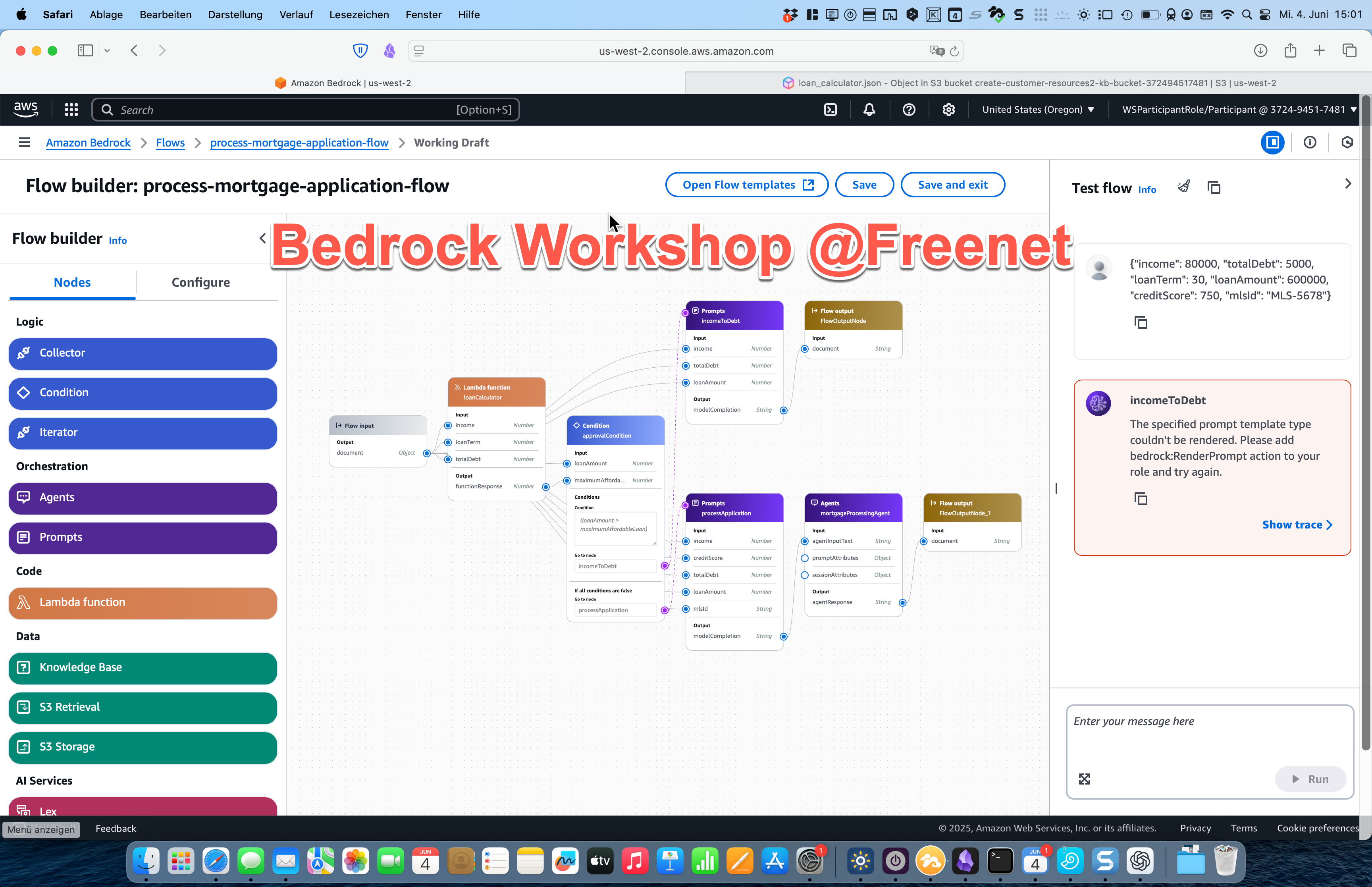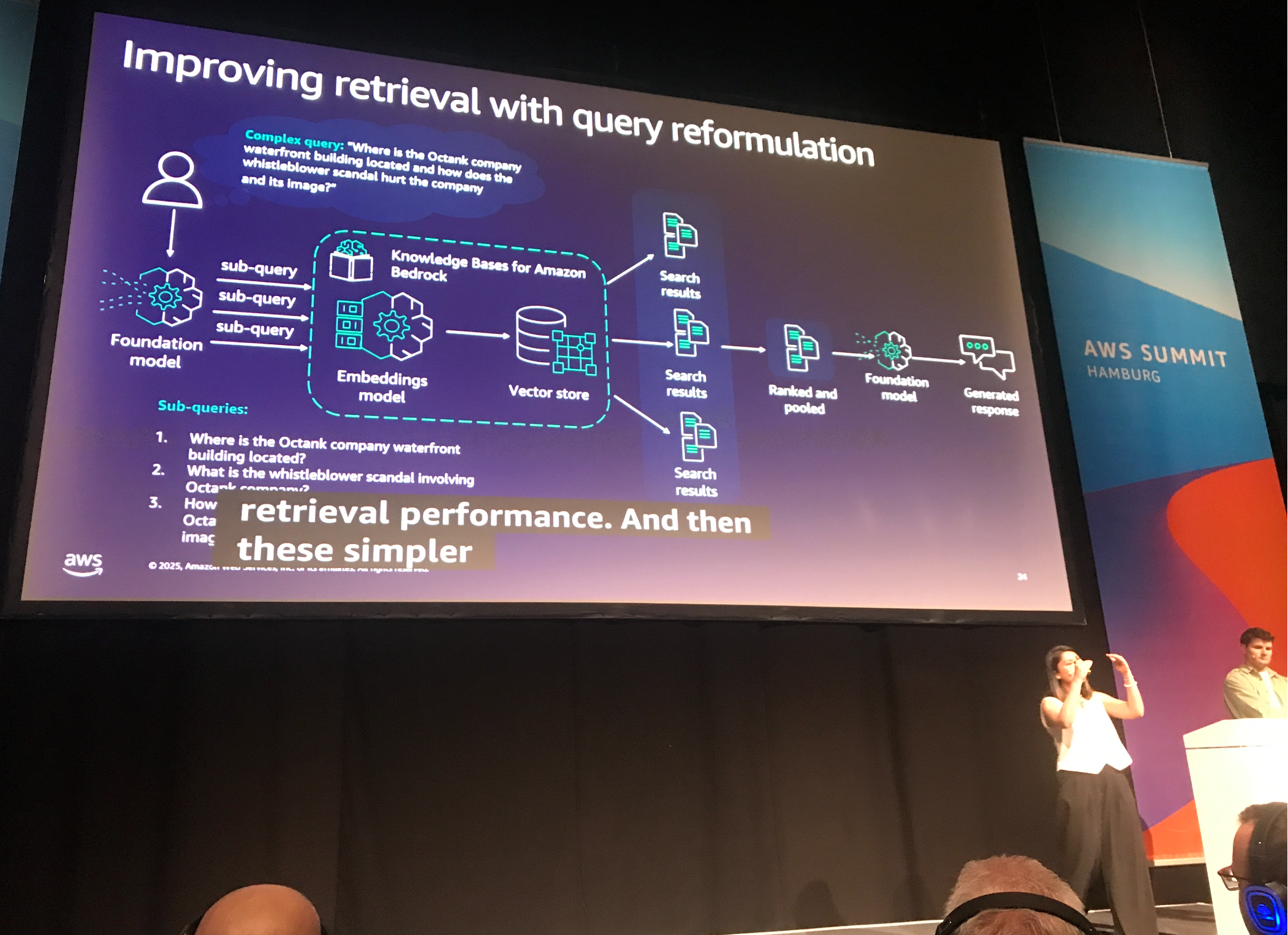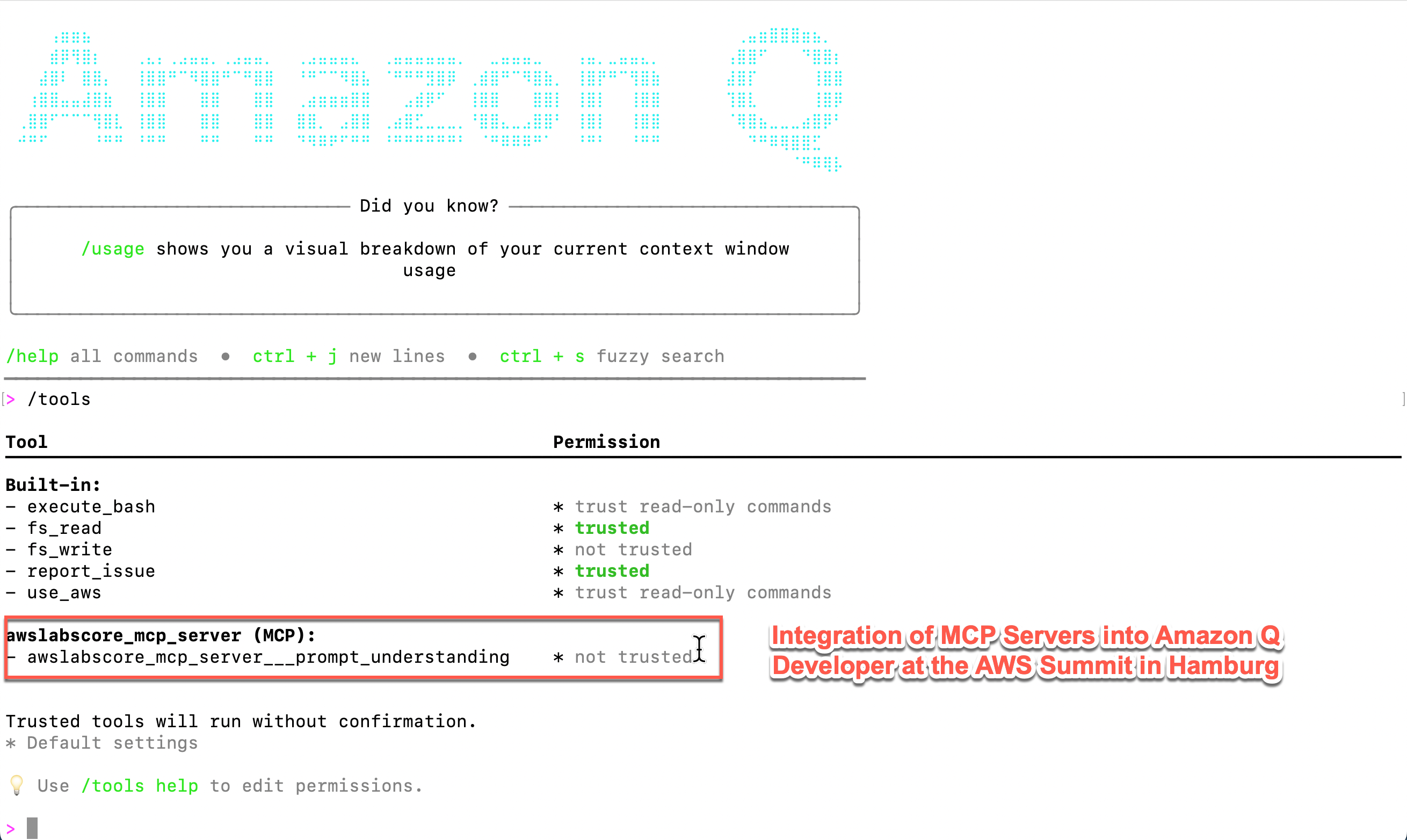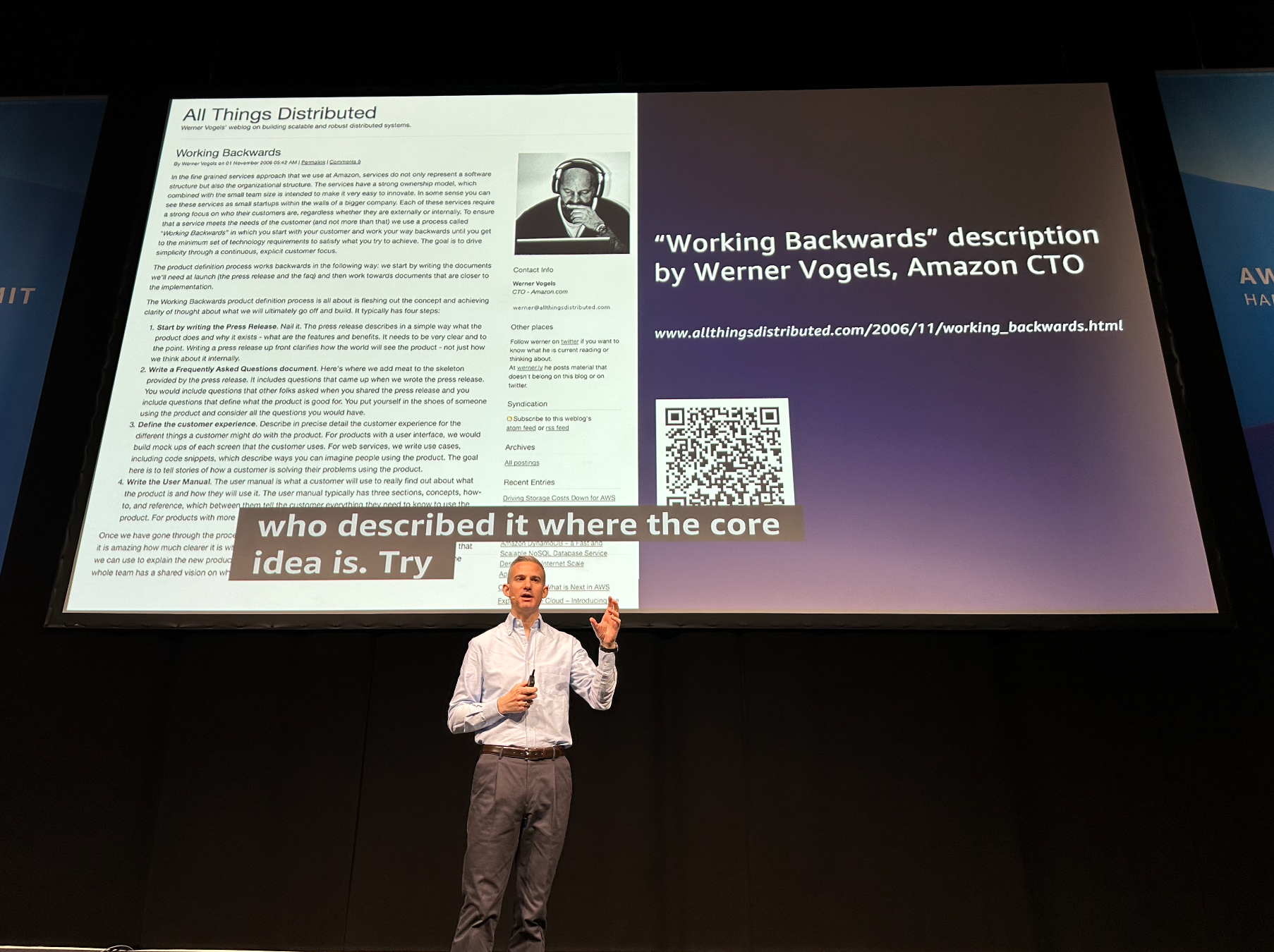1. Summary
Two days between AI euphoria and reality check – what I learnt about Amazon Bedrock, agents and the future of development
📄 Download: PDF Version of this article

Figure 1: Visit to the AWS Summit 2025 in Hamburg
1.1. Summary
The AWS Summit Hamburg 2025 was more than just a regional tech conference – it was a window into the rapid evolution of the generative AI landscape. As a certified Cloud Solution Architect who has spent the last year working extensively with various aspects of generative AI, this two-day event with approximately 5,000 attendees provided me with a unique opportunity to assess the current state of the technology and its adoption in the industry.
I was particularly struck by the fact that a third of all 178 sessions (60 of them) focussed on generative AI. This not only shows the dominance of the topic, but also how deeply this technology has already penetrated companies. At the same time, the conference helped me to place my own open source project – a data-saving chat client deployment – in the context of industrial relevance.
While many large companies are already working extensively with generative AI, there are still many organisations without a clear AI strategy. This is precisely where the relevance of my private AI project becomes clear.
2. The keynote: Fundamental innovation meets practical application
The keynote was, as usual with AWS, a comprehensive showcase of technological advances. Not only the obvious AI features were interesting, but also the fundamental infrastructure services that make this innovation possible.
The global time synchronisation of computers in the millisecond range may seem unspectacular at first glance, but it is the basis for many other services and enables global data synchronisation. Such details show how well thought-out AWS has developed its platform.
The customer stories were particularly interesting: Hapag Lloyd demonstrated how AWS services and generative AI support the process of transporting coffee around the world. Trellix, a cybersecurity company, showed sophisticated Bedrock RAG implementations for structured data analysis. The German Bundesliga DFL Digital Sports uses AI to respond to changing user habits and engage fans with match facts applications such as goal probabilities or shot speeds.
The presentation of AI-supported migration tools for Microsoft .NET applications and VMware workloads to reduce licence costs was a side blow to the competition. Particularly relevant for VMware customers who are looking for alternatives after Broadcom’s controversial licence model change at the end of 2023.
3. Housewarming: Practical workshops with a learning curve
The start of the first day at Freenet and Moia was informative, even if not everything went perfectly. The workshops on Bedrock Agents and Amazon Q Developer were interesting in terms of content, but timed in such a way that there was hardly any time for the desired dialogue with other customers. No breaks, no opportunity for spontaneous conversations – a missed networking opportunity.
The AWS Flow Builder works well: this graphical interface can be used to orchestrate agents for generative AI. However, you also have to look at the flipside – Amazon is forcing a certain vendor lock-in, even if the innovative power is undeniable.

Figure 2: Bedrock Flow Builder at a workshop in the offices of the Freenet Group in Hamburg.
At Moia, Amazon Q Developer was presented as an alternative to GitHub Copilot and Claude Code. What was really exciting was the integration of MCP (Model Context Protocol) servers, which significantly extend the capabilities of these code assistants. In just 30 minutes, with trainer support, I was able to configure an MCP server that analysed my S3 buckets and created a graph. This speed was impressive and shows the potential of this technology.
4. The centrepiece: Agents and RAG in production use
The technical sessions focussed on multi-agent systems and Retrieval Augmented Generation (RAG). These technologies are already in production use at many large customers – mostly developed entirely in-house using AWS Building Blocks, in particular Amazon Bedrock.

Figure 3: Presentation ‘Build scalable RAG applications with Bedrock’
RAG has established itself as the holy grail of knowledge acquisition in agent systems. The technology is amazingly advanced. In a conversation with the speakers of the talk ‘AI Power Search’ from KWS and Adastra, I learned which optimisation measures were most successful in a RAG-based system for scientific articles:
- Input Pipeline Optimisation: Requests are revised, improved and parallelised
- Intelligent chunking: Semantic chunking can significantly increase RAG system performance
- Hybrid search: Amazon OpenSearch is used as a vector database and combines vector search with classic full-text search
Amazon Bedrock now offers a very sophisticated system with numerous building blocks for AI-based solutions. The downside: the unavoidable vendor lock-in.
5. Next generation development tools
In addition to the Amazon Bedrock Flow Builder, Amazon Q Developer was at the centre of the developer tools. The integration of MCP servers is currently only available in the CLI version, but AWS already provides an extensive collection of MCP servers on GitHub, which primarily concern Amazon technologies.

Figure 4: Integration of MSP Server in the Amazon Q CLI
What I find exciting: Public MCP servers can also be integrated, and I expect this to be the next big hit in the field of agentic workflows. In the future, there will probably no longer be a service that is not also offered as an MCP server and can therefore be operated by artificial intelligence.
Although almost all of the business partners’ contributions contained agentic workflows and sophisticated RAG solutions, the aspect of MCP servers was still very sporadic – a sign of how new and forward-looking this technology is.
6. Amazon’s software development process: a look behind the scenes
One particularly interesting presentation shed light on Amazon’s internal software development process. I found the concept of ‘two-pizza teams’ – teams that are so small that two pizzas are enough for everyone – exciting. These teams have complete freedom in their choice of tools and methods, but at the same time are closely integrated into responsibilities.
The whole thing is embedded in comprehensive automation at various levels of the CI/CD pipeline. AI is used extensively for
- Code development and generation
- Code migration
- Security vulnerability scanning
- Code quality checking
Interesting was the reference to Werner Vogel’s article ‘Working Backwards’ – an approach that focuses on customer-centricity and develops products based on customer requirements.

Figure 5: Reference to the blog article by Werner Vogel in the lecture on Amazon’s development process
The high productivity results from a combination of close process and results monitoring on the one hand and high automation plus massive use of AI on the other.
7. The social dimension: a missed opportunity
Amazon is undoubtedly one of the companies that is massively driving AI innovation and benefiting from it. Generative AI will noticeably change the way we live and work together. In this context, I would have liked Amazon to take responsibility and integrate this aspect into the conference.
There was only one presentation that remotely dealt with this: ‘Gen AI in the workplace: productivity, ethics, and change management’. This highlighted the impact of AI on various professions and attempted to provide answers on how to integrate AI development into companies.
The response to resistance from the workforce was disappointing and centred around the provision of ‘AI playgrounds’. The fear of job losses was countered with a quote from Scott Galloway: ‘People are worried that AI is going to take their job? No, someone who understands AI is going to take their job.’
At the same time, there was talk of ‘upskilling’ and ‘rehiring’ – i.e. replacing parts of the workforce that don’t make the leap in qualifications. This leaves me with a bitter aftertaste, especially for those who are struggling with the new requirements.
8. Personal reflection and outlook
The AWS Summit was an impressive demonstration of the latest computer and AI technologies. It showed me how far and deep AI has already penetrated companies and highlighted the latest trends. At the same time, it became clear that the social responsibility of a profit-orientated company is, as expected, very much neglected.
Important insights emerged for my own Private AI project:
- The relevance of data-saving solutions is increasing, as many companies do not yet have a clear AI strategy
- RAG technologies are more mature than expected
- MCP servers will be the next big thing in agentic workflow development
- The gap between AI-savvy and traditional companies is widening
As a Cloud Solution Architect with a year of intensive GenAI experience, I felt vindicated in my assessment that we are at the beginning of a fundamental transformation. The technology is there, the building blocks are available, and the early adopters are already pulling away.
9. Practical insights and resources
9.1. Key tech trends:
- Multi-agent systems are becoming standard in enterprise AI implementations
- RAG optimisation through semantic chunking and hybrid search
- MCP server as a game changer for agentic workflows
- Amazon Bedrock as a comprehensive AI building block system
9.2. Relevant links and tools:
- Amazon Bedrock Agents – Comprehensive agent orchestration
- Amazon Q Developer – AI-powered code assistant
- AWS MCP Server Collection – Collection of available MCP servers
- Werner Vogel’s ‘Working Backwards’ – Customer-Centric Development
- Blog Article about my Private-AI Project – Open-Source project for a privacy focussed Chat Application.
9.3. Workshop experiences:
- Bedrock Agent Flows at Freenet – Graphical Agent Orchestration
- Amazon Q Developer at Moia – MCP server integration in practice
- Live configuration of S3 analytics MCP server in 30 minutes
The AWS Summit Hamburg 2025 was not just a conference – it was a compass for the future of AI-supported software development and a wake-up call for all those who are not yet taking this transformation seriously enough.
